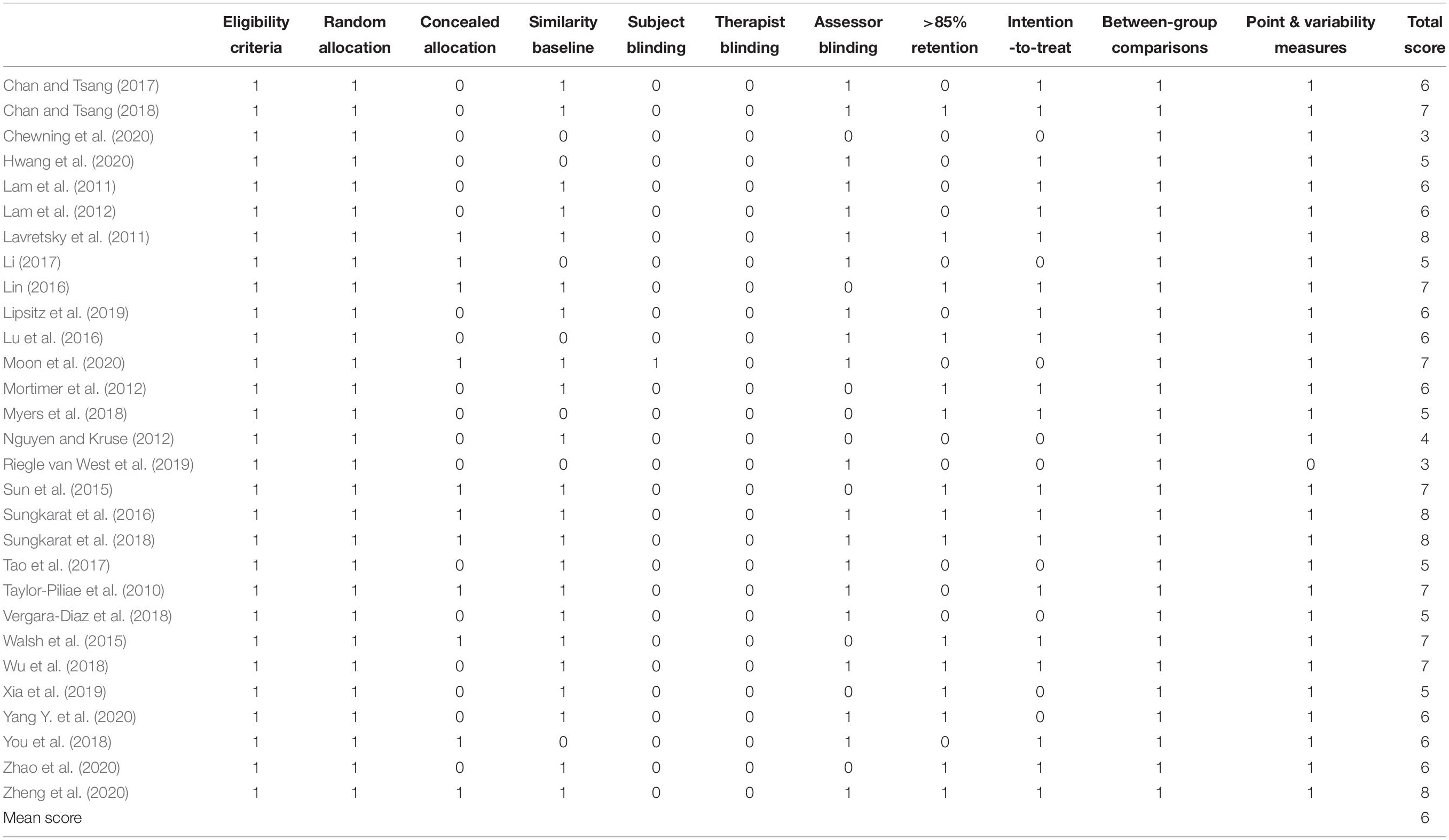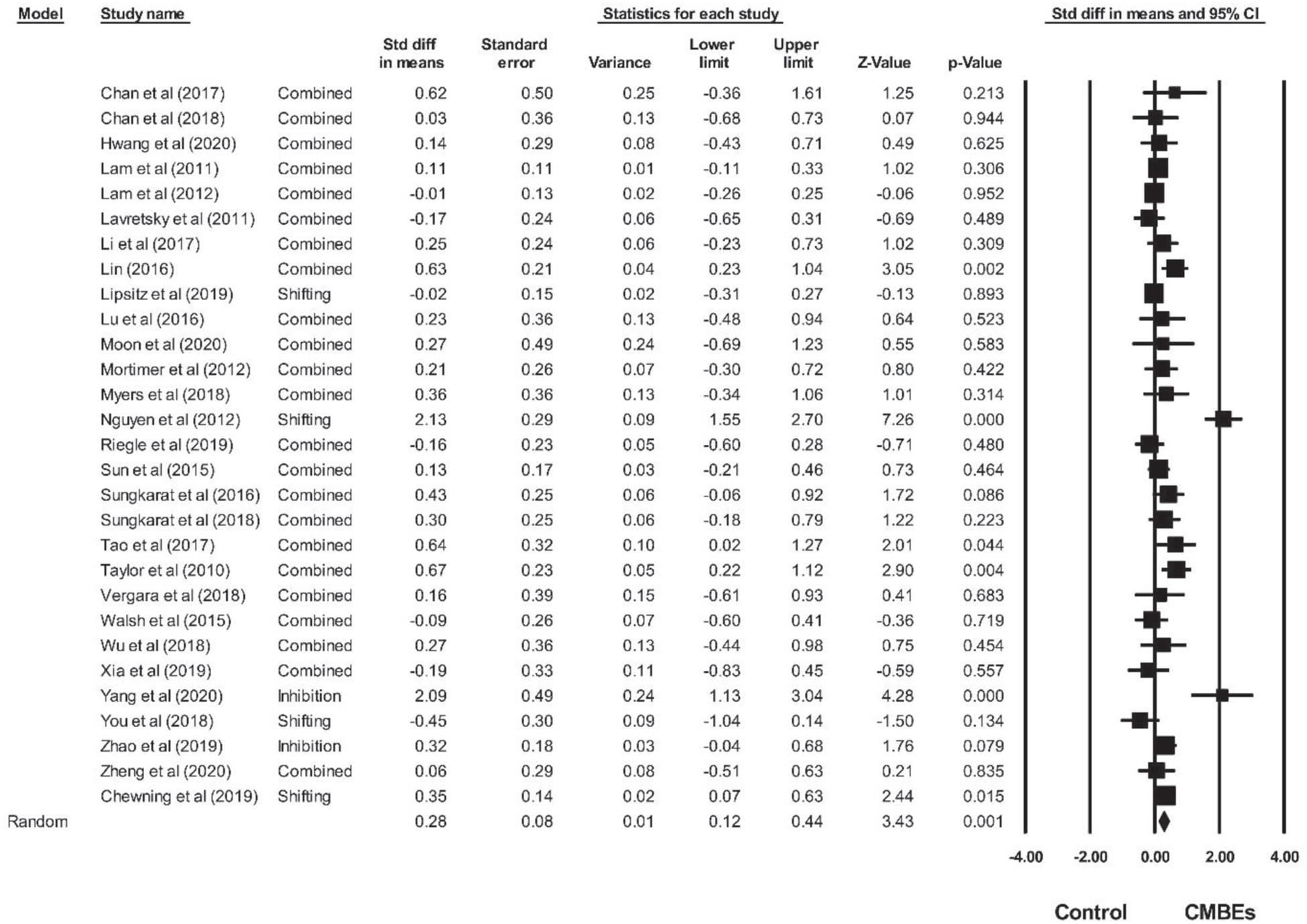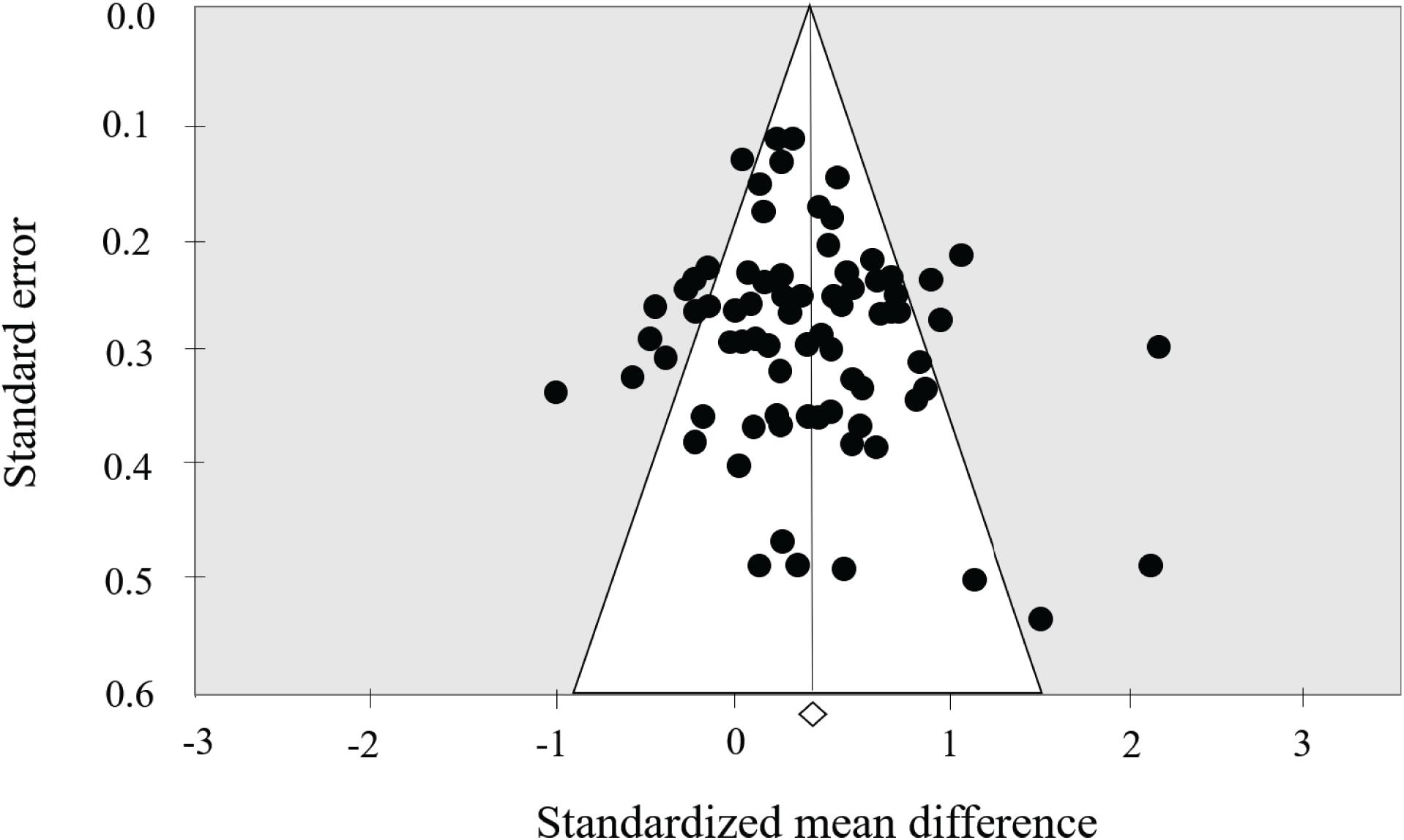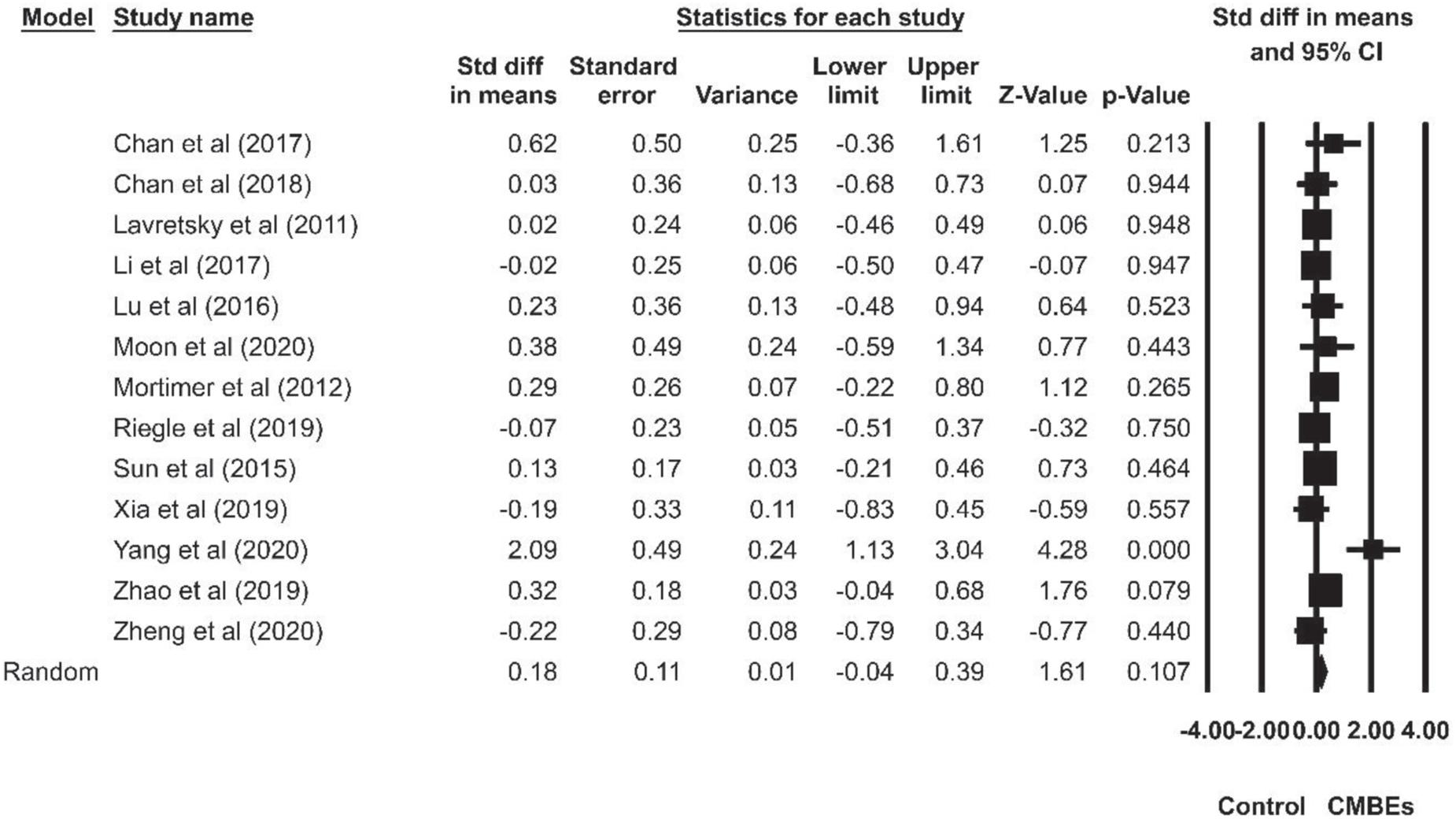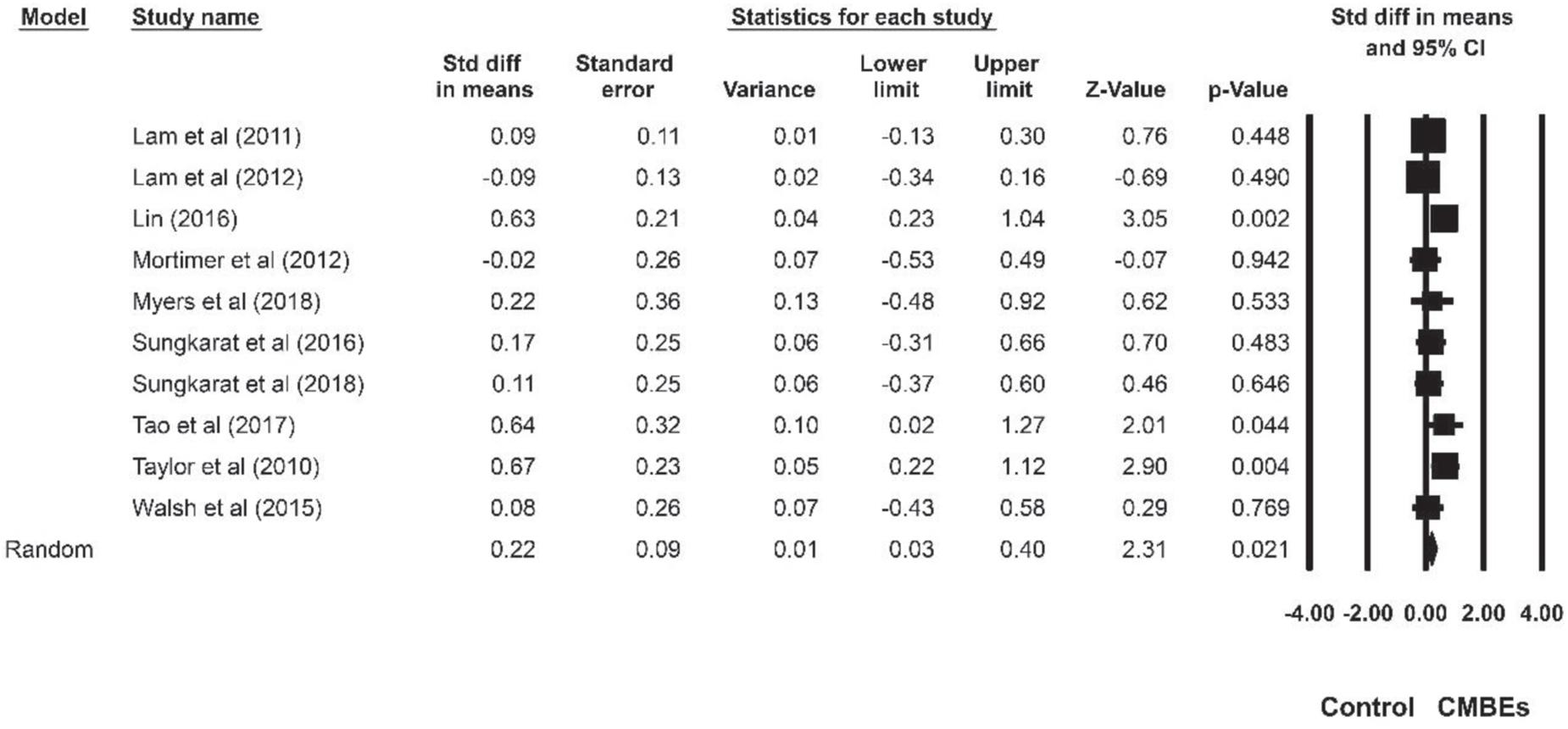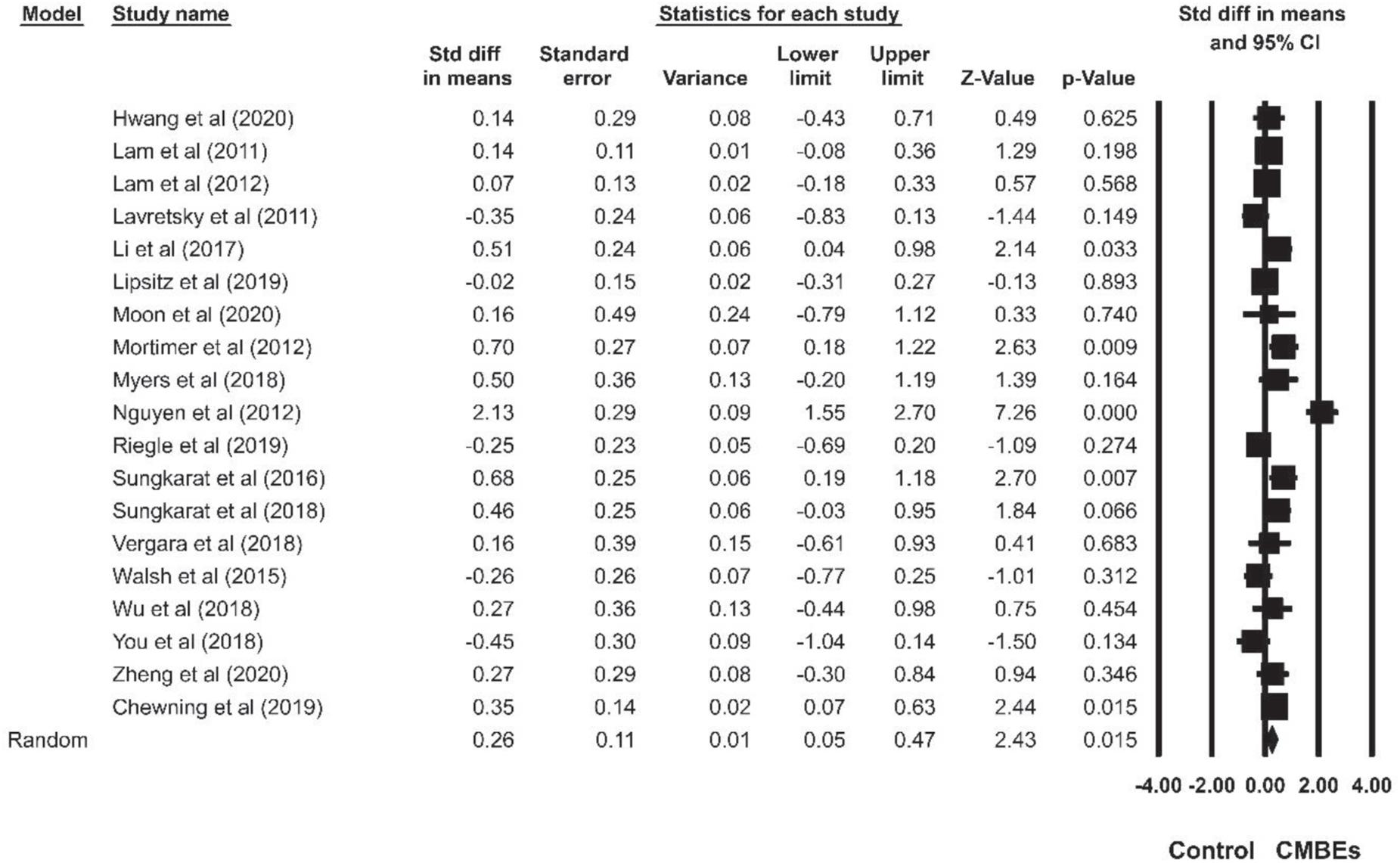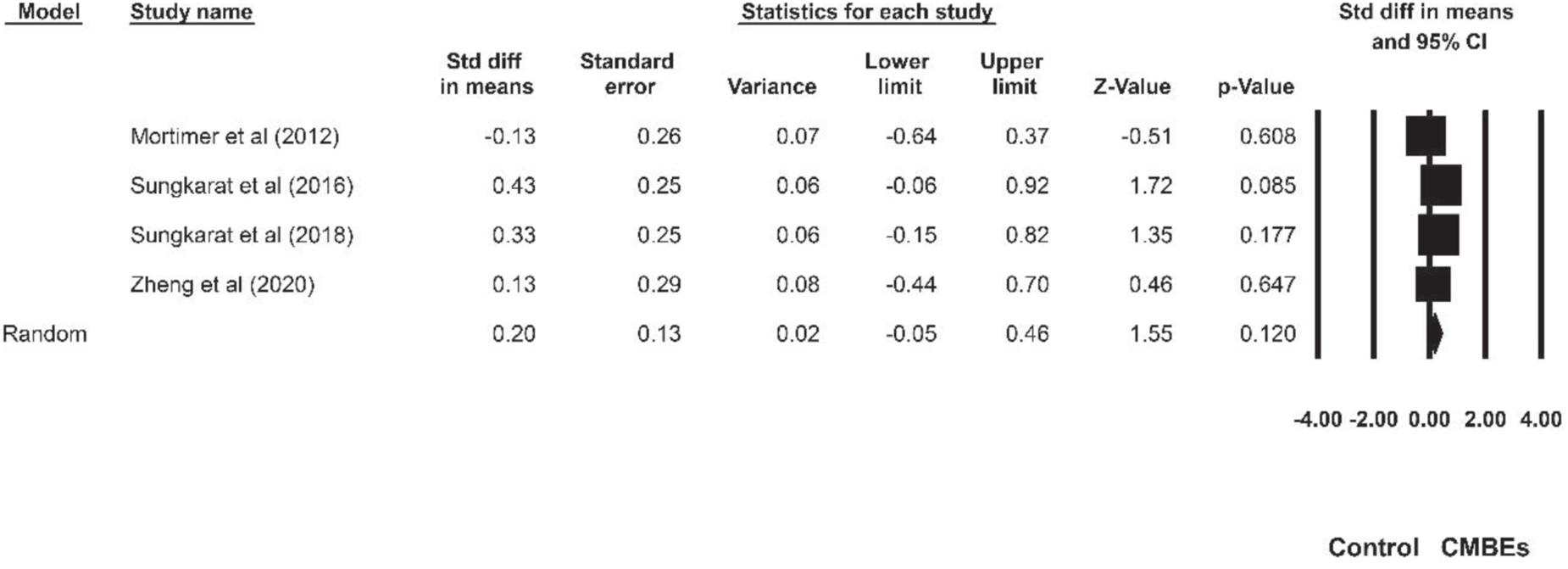- 1Department of Physical Education, Beijing Language and Culture University, Beijing, China
- 2Sport Neuroscience Division, Advanced Research Initiative for Human High Performance, Faculty of Health and Sport Sciences, University of Tsukuba, Ibaraki, Japan
- 3College of Physical Education, Nanjing Xiaozhuang University, Nanjing, China
- 4Tzu Chi Medical Foundation, Alhambra, CA, United States
- 5Integration Center of Traditional Chinese and Modern Medicine, Hualien Tzu Chi Hospital, Hualien, Taiwan
- 6Department of Chinese Medicine, Hualien Tzu Chi Hospital, Hualien, Taiwan
- 7Department of Physical Education, National Taiwan Normal University, Taipei, Taiwan
- 8Institute for Research Excellence in Learning Science, National Taiwan Normal University, Taipei, Taiwan
Chinese mind-body exercises (CMBEs) are positively associated with executive function (EF), but their effects on EF, from synthesized evidence using systematic and meta-analytic reviews, have not been conducted. Therefore, the present systematic review with meta-analysis attempted to determine whether CMBEs affect EF and its sub-domains, as well as how exercise, sample, and study characteristics moderate the causal relationship between CMBEs and EF in middle-aged and older adults. Seven electronic databases were searched for relevant studies published from the inception of each database through June 2020 (PubMed, Web of Science, Embase, Cochrane Controlled Trials Register, Wanfang, China National Knowledge Infrastructure, and Weipu). Randomized controlled trials with at least one outcome measure of CMBEs on EF in adults of mean age ≥ 50 years with intact cognition or mild cognitive impairment (MCI) and with or without chronic diseases were included. A total of 29 studies (N = 2,934) ultimately were included in this study. The results indicated that CMBEs improved overall EF (Standardized Mean Differences = 0.28, 95% CI 0.12, 0.44), as well as its sub-domains of working memory and shifting. The beneficial effects of CMBEs on EF occurred regardless of type (Tai Chi, Qigong), frequency of group classes (≤2 time, 3-4 time, ≥5 times), session time (≤45 min, 46-60 min), total training time (≥150 to ≤300 min, >300 min), and length of the CMBEs (4-12 week, 13-26 week, and >26 week), in addition to that more frequent participation in both group classes and home practice sessions (≥5 times per week) resulted in more beneficial effects. The positive effects of CMBEs on EF were also demonstrated, regardless of participants mean age (50-65 years old, >65 years old), sex (only female, both), and cognitive statuses (normal, MCI, not mentioned), health status (with chronic disease, without chronic disease), as well as training mode (group class, group class plus home practice) and study language (English, Chinese). This review thus suggests that CMBEs can be used as an effective method with small to moderate and positive effects in enhancing EF, and that more frequent group classes and home practice sessions may increase these effects. However, certain limitations, including strictly design studies, limited ES (effect size) samples for specific variables, and possible biased publications, required paying particular attention to, for further exploring the effects of CMBEs on EF.
Introduction
As people grow older, they are susceptible to decline in executive function (EF) (Zaninotto et al., 2018; Caballero et al., 2020). EF is a meta-level and top-down mental process that involves purposeful efforts to supervise, monitor, and control non-automatic behaviors in order to achieve consciously chosen goals (Diamond, 2013). In structural terms, EF can be differentiated into two dimensions, namely, core EF, which in turn involves three distinguishable sub-domains (i.e., inhibition, working memory, and shifting) (Diamond, 2020), and higher-level EF, which involves planning and problem-solving (Romine and Reynolds, 2005). Specifically, inhibition refers to the capacity to deliberately suppress or control a prepotent/dominant stimulus, and to filter out irrelevant cues (Zhan et al., 2020); working memory refers to an ability to hold and manipulate relevant information in the mind temporarily (Miyake et al., 2000); shifting is defined as the capacity to flexibly switch back-and-forth between mental sets, operations or conceptual representations (Kofler et al., 2019); and planning and problem-solving refer to developing an organized approach for accomplishing actions in advance and are aimed at finding out how to reach a specific goal (Mefoh et al., 2017). While consistent decline in both dimensions of EF is observed with aging, the rates and trajectories of those decline are significantly predicted by environmental and lifestyle factors, such as physical activity (Etnier and Chang, 2019; Chen et al., 2020a), fitness level (Bento-Torres et al., 2019), cognitive training (Nguyen et al., 2019), and social interaction and meditation (Chang et al., 2019; Caballero et al., 2020).
Chinese mind-body exercises (CMBEs) are characterized as multi-modal form of exercises that incorporate aerobic exercise, muscular exercise, coordinative exercise, social interaction, and meditation (Chang et al., 2014). CMBEs can be divided into Tai Chi/Tai Chi Chuan and Qigong and seem to be a promising activity for delaying cognitive decline or improving cognitive functions, including memory, attention, cognitive flexibility, and visuospatial perception (Lim et al., 2019; Yang J. et al., 2020). Furthermore, current systematic reviews further demonstrated that CMBEs can be a way to protect against cognitive decline in older adults (Zheng et al., 2015; Zhang et al., 2018). CMBEs also involve mental stimulation through memorizing, concentrating, and meditating during a series of postures, such that CMBEs simultaneously facilitate physical, cognitive, social, and even spiritual functions (Fong et al., 2014; Wayne et al., 2014; Zhang et al., 2018). Studies associated with CMBEs on EF have mainly focused on Tai Chi (Miller and Taylor-Piliae, 2014; Wayne et al., 2014; Chan et al., 2019; Wei et al., 2020). Despite that Tai Chi has shown benefits compared to other single forms of exercise (e.g., aerobic exercise and resistance exercise) (Northey et al., 2018; Chen et al., 2020a), these studies have either focused on an overall EF with a small number of RCT studies (k = 4) (Wayne et al., 2014) or a specific EF sub-domain with a limited number of RCT and Non-RCT studies (k = 2-5) without considering core EF and higher-level EF in particular (Wu et al., 2013; Zheng et al., 2015). Additionally, some studies have shown that Tai Chi had evidenced no improvements on EF in older adults (Hall et al., 2009; Gerritsen et al., 2020). Such various results suggest that a comprehensive understanding of the effects of CMBEs on EF is still lacking.
The strength of the effects of CMBEs on EF may be influenced by factors related to exercise characteristics, individual background, and study design. The frequency, intensity, time, type, volume, and progression (FITT-VP) of an exercise have been hypothesized as relevant for optimizing the effects of the exercise (ACSM, 2018). Relatedly, Chen et al. (2020a) reported that exercise training interventions with a frequency of 3 to 4 times per week, performed with vigorous intensity, or a total length of training period ranging from 1 to 3 months, demonstrated larger effects on overall EF. However, previous reviews did not focus on specific CMBEs interventions and the moderators, regarding that the effects of FITT-VP for CMBEs are still under investigated. Moreover, individual background factors including age, sex, cognitive status, and health status may also influence the relationship between CMBEs and EF. For example, while Tai Chi has been found to improve EF in healthy adults, it was associated with heterogenous EF outcomes in older adults with early-stage dementia (Lim et al., 2019; Yang J. et al., 2020). Meanwhile, the design of a study (e.g., whether a study includes a control group with active or passive status or includes group classes combined with home practice sessions) may also affect the influences of CMBEs on EF found by the study, such that aspects of study design require further consideration.
In this study, we attempted to fill three research gaps by conducting a systematic review and meta-analysis, targeting randomized controlled trial (RCT) studies examining the effects of CMBEs on EF in middle-aged and older adults with intact cognition and mild cognitive impairment (MCI). In additional to cognitive status, the review also targets on participants with or without chronic diseases. Specifically, our primary aim was to determine whether CMBEs affect EF and its sub-domains of core EF and higher-level EF. Additionally, subgroup analyses of exercise characteristics were performed in order to better understand the dose-related effects of CMBEs interventions. Lastly, analyses were also conducted to determine whether moderators such as individual background factors and study design factors affect the casual relationship between CMBEs and EF.
Methods
Design and Eligibility Criteria
This systematic review and meta-analysis was conducted following the Preferred Reporting Items for Systematic Reviews and Meta-Analyses (PRISMA) guidelines (Liberati et al., 2009) and the Cochrane Collaboration Handbook guidelines (Higgins et al., 2019).
Eligible articles were included, according to the following PICOS criteria: Participants: studies included adults aged ≥ 50 years who had intact cognition or those diagnosed with MCI. Participants with or without chronic diseases (e.g., traumatic brain injury, Parkinson’s disease, diabetes, depression, stroke) were also included. Interventions: only studies involving interventions consisting exclusively of CMBEs (i.e., Tai Chi or Qigong) were included, while studies involving interventions combining Tai Chi or Qigong with other types of interventions (e.g., dance, memory intervention, and transcranial direct current stimulation interventions) were excluded. Control groups: studies using either active control group (e.g., physical exercise, educational program, social interaction, cognitive training) or passive control group (e.g., usual care, waitlist control, no intervention) were included. Outcome: studies including EF outcomes were examined. Study design: only RCT studies were included. Furthermore, eligible articles were published in either peer-reviewed journal in English or consisted of high-quality research (i.e., doctoral dissertations and papers published in Core Chinese periodicals) in Chinese.
Literature Search
Electronic articles published from the inception of a given database through June of 2020 were searched for in seven databases, namely, the PubMed, Web of Science, Embase, CENTRAL, Wanfang, China National Knowledge Infrastructure, and Weipu databases.
The article searches were conducted by two authors (FFR and FTC), and the search strategy consisted of using medical subject headings (MeSH) for “Tai Ji” OR Qigong AND executive function OR cognition AND randomized control trial (Supplementary 1). After searching for relevant articles, the same two authors (FFR and FFC) first screened the titles and abstracts of potentially eligible articles in accordance with the eligibility criteria. Then, the full-text articles were independently reviewed. If any disagreements occurred between the two authors, the third author (YKC) was consulted until a consensus was reached.
Data Extraction
The data extraction strategy used was mainly inspired by recent meta-analyses (Northey et al., 2018; Xue et al., 2019; Chen et al., 2020a), and the process of data extraction was conducted according to the Cochrane Collaboration Handbook (Higgins et al., 2019). In this respect, two authors (FFR and FTC) extracted the relevant data from the included studies in a standardized manner.
The data extracted included the following: study (authors, year) and language, participants (age, sex, cognitive/health status), grouping and sample size, CMBE interventions [frequency of group classes (GC), frequency of home practice sessions (HP), session time of GC, length], and EF sub-domain. Furthermore, the following exercise characteristics were calculated: frequency of GC/frequency of group classes plus home practices (GC/GC + HP) and total training time of GC/GC + HP per week.
For each included study, the change of mean (meanchange) and the standard deviation of change (SDchange) from pre-test to post-test were extracted. If these values were not available, they were calculated using the following formula: “meanchange = meanpost - meanpre” and “SDchange = Square root (SQRT) [(SD pre2 + SD post2) – (2 × Corr × SDpre × SDpost)],” while the correlation coefficient (Corr) was set as 0.5 (Higgins and Green, 2005; Xue et al., 2019). When articles only reported standard errors (SEs) or 95% confidence intervals (CIs), the SD was computed using the formula “SD = SE × SQRT (n) or SD = SQRT (n) × [(upper limit - lower limit)/3.92].” If the change values or mean and SD-values of pre-test and post-test were not reported, the sample sizes and p-Value were used to calculate the effect size. If any relevant data was missing data, the corresponding author or authors were contacted by the first researcher via email (Higgins et al., 2019).
The overall EF was calculated by using all of the EF outcomes and the EF sub-domains were classified into four areas (core EF: inhibition, working memory, shifting; high-level EF: planning) based upon relevant EF assessments (Table 1).
With respect to exercise characteristics followed by FITT-VP, six variables were focused on and coded in terms of categories: (1) CMBEs types were coded as Tai Chi and Qigong; (2) frequencies of GC were coded as low (≤2 times), moderate (3-4 times), and high (≥5 times); (3) frequencies of GC/frequencies of GC + HP were also coded as low (≤2 times), moderate (3-4 times), and high (≥5 times); (4) session times of GC were coded as short (≤45 min), moderate (>45 to ≤60 min), and long (>60 min); (5) total training times of GC/GC + HP per week were coded as short (<150 min), moderate (≥150 to ≤300 min), and long (>300 min); and (6) intervention lengths were coded as short (4-12 weeks), moderate (13-26 weeks), and long (>26 weeks). Regarding intensity of CMBEs, most studies did not provide the details, so the variable was not included.
With regard to sample and study characteristics, seven variables were targeted and coded in terms of categories: (1) mean ages were coded as 50-65 years old and >65 years old; (2) sex were coded as female only and both; (3) cognitive statuses were coded as normal, MCI, and not mentioned; (4) health statuses were coded as without chronic disease and with chronic disease; (5) control groups were coded as active control and passive control group; (6) training modes were coded as GC and GC + HP; and (7) languages were coded as English and Chinese.
Assessment of Study Quality
The quality of the included studies was assessed independently by two authors (FFR and FTC) based on the principles of the Physiotherapy Evidence Database (PEDro). The PEDro scale includes 11 items (eligibility criteria, random allocation, Concealed allocation, similarity baseline, subject blinding, Therapist blinding, Assessor blinding, >85% retention, Intention-to-treat, Between-group comparisons, Point & variability measures), and each study was assessed as either “yes” (score 1) or “no” (score 0) for each of those items. According to the PEDro guidelines, the maximum total score is 10 (item 1 is not used to compute the total score, since it is linked with external validity). If a study receives a score of 9 or 10, it is considered to be of very good quality, while a score of 6 to 8 indicates good quality, a score of 4 or 5 indicates medium quality, and a score of 0 to 3 indicates poor quality (Maher et al., 2003). Any score on which the two authors disagreed was discussed with the third author (YKC) until a consensus was achieved.
Statistical Analysis
This meta-analysis was performed using Comprehensive Meta-Analysis (CMA) Software, Version 3.0 (Biostat, Englewood, NJ, United States), and the random-effects model was applied based on the assumption of different true effect sizes (Higgins et al., 2019). Random effect model was recommended for meta-analysis with that the true effect sizes were not identical (Kisamore and Brannick, 2008; Schmidt et al., 2009), thus this model was used in the review.
The pooled effect sizes were estimated with standardized mean differences (SMD) and 95% CIs. A positive effect size (ES) indicated that the CMBEs group outperformed the control groups. A p-value of 0.05 was regarded as significantly improvement for CMBEs group in comparison to the control groups. The magnitudes of the ESs were classified as small (0.20 to 0.49), moderate (0.50 to 0.79), and large (0.80 to 1.00) (Wilson et al., 2019). The statistical heterogeneity was evaluated using the Q statistic and I2 values, which range from 0 to 100% (1-49% = small, 50-74% = medium, 75-100% = large, Higgins et al., 2003). In addition, publication bias was assessed by generating a funnel plot and conducting Egger’s regression test.
The steps of the meta-analysis were as follows: (1) the overall effect of CMBEs on the overall EF was calculated. (2) Subgroup analysis was conducted on categorical moderators to examine the effects of CMBEs on EF in terms of three groups, including (1) the EF sub-domains (i.e., inhibition, working memory, shifting, and planning); (2) exercise characteristics (i.e., type, frequency of GC, frequency of GC/GC + HP, session time of GC, total training time of GC/GC + HP per week, and length); (3) sample and study characteristics (age, sex, cognitive status, health status, control groups, training mode, and language).
Results
Study Identification and Selection
The flow of the study identification and selection process is summarized in Figure 1. The initial search identified 1,544 potentially relevant articles (1,262 articles in English and 282 articles in Chinese). After removing duplicate citations (k = 522), 1,022 articles remained for screening according to their titles and abstracts. The screening process left 89 full-text articles, of which 29 RCT articles with a total of 2,934 participants (Table 2), including 26 articles in English (Taylor-Piliae et al., 2010; Lam et al., 2011, 2012; Lavretsky et al., 2011; Mortimer et al., 2012; Nguyen and Kruse, 2012; Sun et al., 2015; Walsh et al., 2015; Lu et al., 2016; Sungkarat et al., 2016, 2018; Chan and Tsang, 2017, 2018; Tao et al., 2017; Myers et al., 2018; Vergara-Diaz et al., 2018; Wu et al., 2018; You et al., 2018; Lipsitz et al., 2019; Riegle van West et al., 2019; Xia et al., 2019; Chewning et al., 2020; Hwang et al., 2020; Moon et al., 2020; Yang Y. et al., 2020; Zheng et al., 2020) and 3 articles in Chinese (Lin, 2016; Li, 2017; Zhao et al., 2020) met the eligibility criteria for qualitative analysis. Data for two articles with missing data were made available upon request (Lavretsky et al., 2011; Riegle van West et al., 2019), and all 29 articles were ultimately included in the quantitative synthesis.
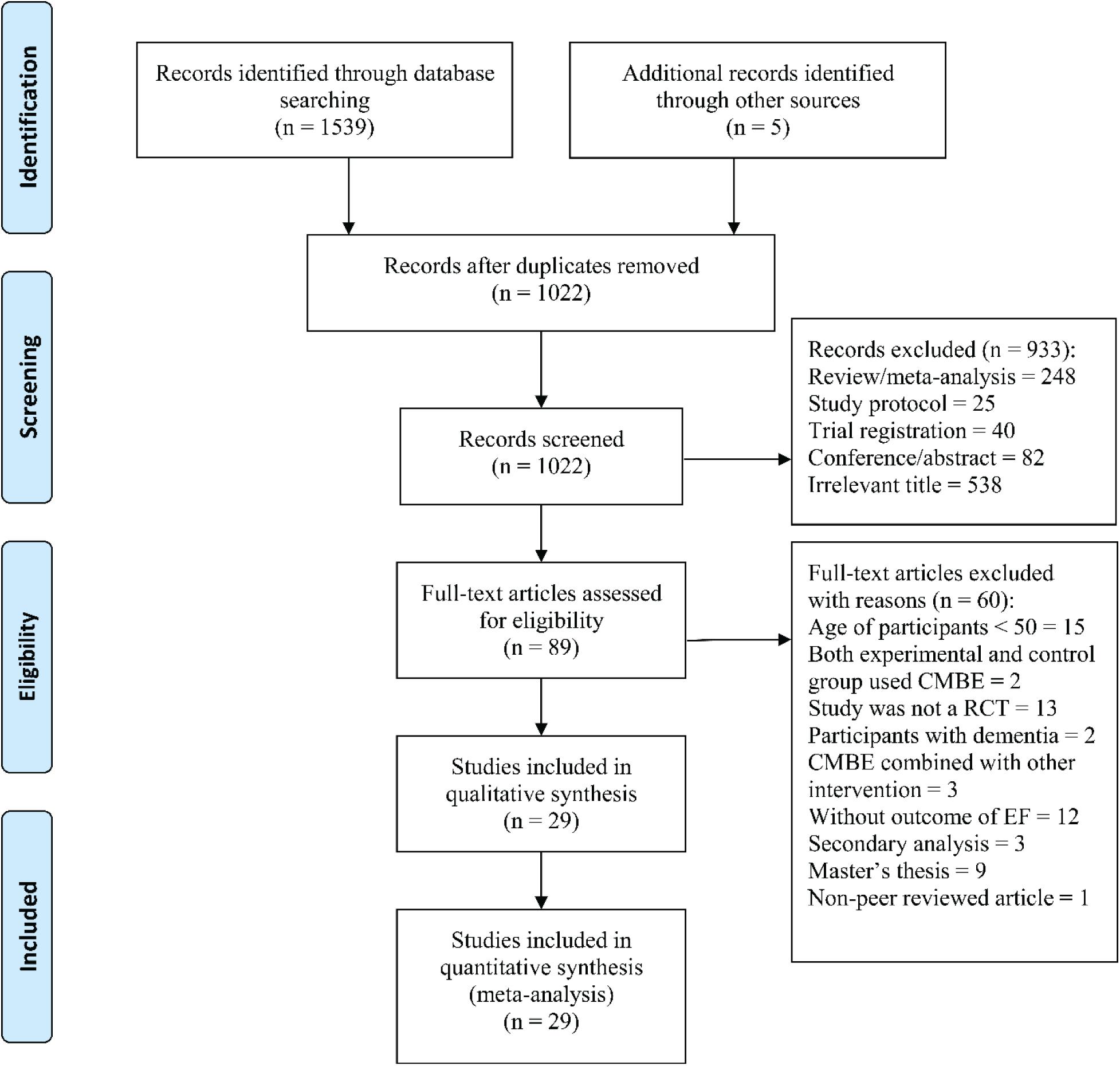
Figure 1. Preferred Reporting Items for Systematic Reviews and Meta-Analyses flow chart of the study identification and selection process. CMBEs, Chinese mind-body exercises; RCT, randomized controlled trial; EF, executive function; n, number.
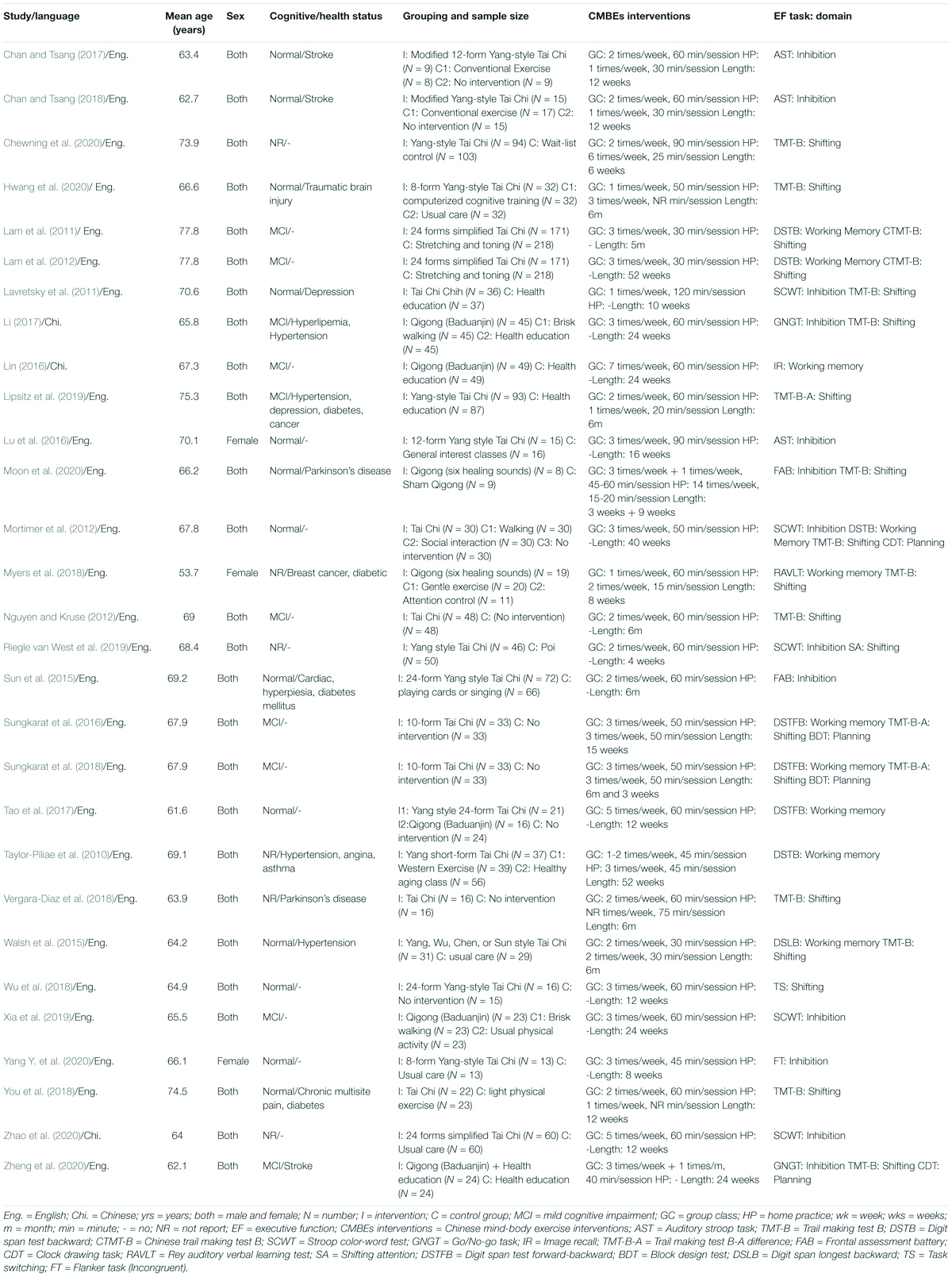
Table 2. Overview of characteristics associated with Chinese mind-body exercises and executive function studies (n = 29).
Characteristics of Included Studies
With respect to the sample characteristics of the included studies, the mean ages of the participants ranged from 53.7 to 77.8 years old. Among the included articles (k = 29), 26 investigated both male and female participants and 3 focused exclusively on female subjects. With regard to cognitive status, 13 studies targeted participants with intact (normal) cognitive status, 10 studies for MCI, and 6 studies does not provide the details. We also found that 14 of the studies targeted participants with chronic diseases (e.g., traumatic brain injury, Parkinson’s disease, diabetes, depression, and stroke).
With regard to exercise characteristics, 23 studies focused on Tai Chi and 7 studies focused on Qigong. In terms of control groups, 19 studies used an active control group and 14 studies used a passive control group. The frequency of the CMBEs investigated in the studies ranged from 1 to 7 times. The session time for group classes varied from 30 minutes to 120 minutes. The overall length of the interventions ranged from 4 weeks to 52 weeks. Furthermore, 13 studies used group classes plus home practice sessions for their interventions and 16 studies used group classes only.
With respect to EF sub-domains, 19 studies examined shifting as the EF outcome. In addition, 13 studies targeted inhibition and 10 studies targeted working memory. The review found that there were only 4 studies that assessed the planning aspect of EF.
The quality assessment results of the included studies are shown in Table 3. The results indicated that 20 of the studies received scores of 6-8 (good quality), 7 studies received scores of 4-5 (median quality), and two studies received scores of 3 (poor quality). Overall, the mean quality of the included studies was scored as 6.
Overall Analysis, Heterogeneity, and Small Sample Size Bias
The results indicated significant improvement in overall EF after the CMBEs interventions in the participating older adults. The pooled ES for CMBEs was significant and small ES (SMD = 0.28, 95% CI 0.12 to 0.44, p = 0.001), with medium heterogeneity (I2 = 68.96%, p < 0.001) compared to the control groups (Figure 2). Regarding publication bias, visual inspection of the funnel plot showed that it was symmetrical, and the results further showed a non-significant Egger’s regression intercept (t = 1.50, p = 0.14) revealing the absence of funnel plot asymmetry (Figure 3).
Subgroup Analysis
The results of the subgroup analyses are summarized in Table 4 and described below. To ensure the most beneficial effect on EF, we performed the subgroup analyses to examine the moderating roles of different factors on the effects of CMBEs on EF, with the analyses including EF sub-domains, as well as exercise, sample, and study characteristics.
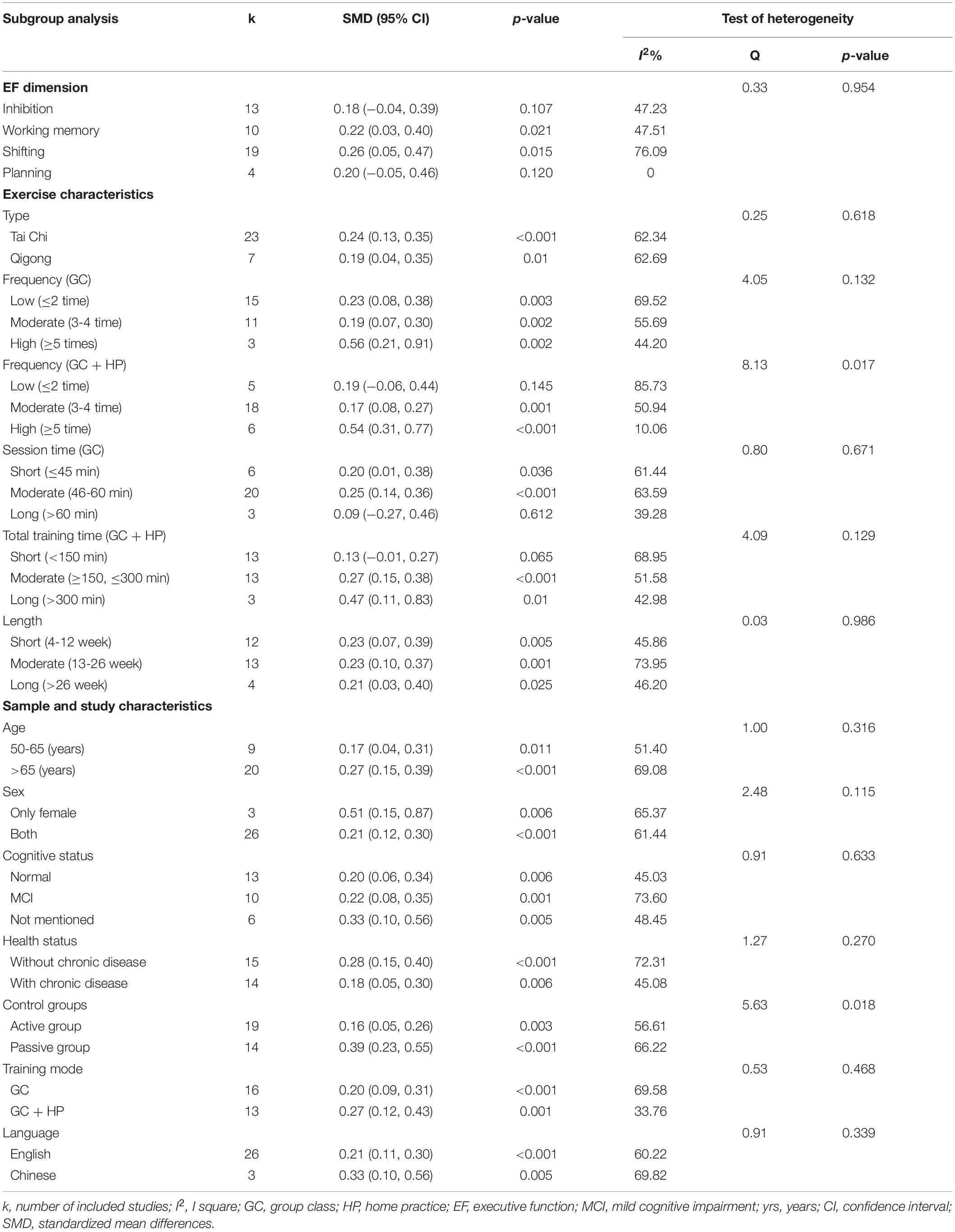
Table 4. Analysis and subgroup analysis results regarding the effects of Chinese mind-body exercises on executive function.
EF Sub-Domains
The results indicated no significant differences among the four sub-domains of EF after the CMBEs interventions (p = 0.954) (Table 4). Regarding the core EF, there was no significant ES for inhibition (SMD = 0.18, p = 0.107) compared to the control groups (Figure 4). Additionally, the results indicated that there were significant and small ESs for both working memory (SMD = 0.22, p = 0.021) and shifting (SMD = 0.26, p = 0.015) compared to the control groups (Figures 5, 6). Regarding the higher-level EF, the results showed no significant ES for planning (SMD = 0.20, p = 0.120) compared to the control groups (Figure 7).
Exercise Characteristics
Regarding exercise type, there was no significant difference between the two types of CMBEs (p = 0.618), and the results showed significant and small ESs for both Tai Chi (SMD = 0.24, p < 0.001) and Qigong interventions (SMD = 0.19, p = 0.01) compared to the control groups.
With regard to frequency, the present study focused on the frequency of GC and the frequency of GC/GC + HP. Regarding frequency of GC, the results indicated that there was no significant difference among the three variables (p = 0.132), revealing a significant and moderate ES for high frequency (SMD = 0.56, p = 0.002), significant and small ESs for both low frequency (SMD = 0.23, p = 0.003) and moderate frequency (SMD = 0.19, p = 0.002) interventions as compared to the control groups. Regarding the frequency of GC/GC + HP, the results indicated that effect of CMBEs on EF was significantly influenced by the frequency of GC + HP (p = 0.017). The results revealed that there was a significant and moderate ES for high frequency (SMD = 0.54, p < 0.001) and a significant and small ES for moderate frequency (SMD = 0.17, p = 0.001), but a non-significant ES for low frequency (SMD = 0.19, p = 0.145) compared to the control groups.
With respect to session time and total training time, the results showed no significant difference among the three session time ranges (p = 0.671). The results indicated significant and small ESs for both short session times (≤45 min) (SMD = 0.20, p = 0.036) and moderate session times (46-60 min) (SMD = 0.25, p < 0.001) compared to the control groups. In contrast, there was no significant ES for long session times (>60 min) (SMD = 0.09, p = 0.612). The results indicated no significant difference among the three ranges of total training time per week (p = 0.129). The results indicated significant and small ESs for both long total training times (>300 min) (SMD = 0.47, p = 0.01) and moderate total training times (≥150, ≤300 min) (SMD = 0.27, p < 0.001), but a non-significant ES for short total training times (<150 min) (SMD = 0.13, p = 0.065) compared to the control groups.
Regarding CMBEs length, there was no significant difference among the three ranges of length (p = 0.986). The results revealed significant and small ESs for short lengths (4-12 weeks) (SMD = 0.23, p = 0.005) and moderate lengths (13-26 weeks) (SMD = 0.23, p = 0.001), as well as for long lengths (>26 weeks) (SMD = 0.21, p = 0.025) compared to the control groups.
Sample and Study Characteristics
With regard to mean age, there was no significant difference between individuals aged 50-65 years old and individuals aged > 65 years old (p = 0.316). The results showed significant and small ESs for individuals aged > 65 years old (SMD = 0.27, p < 0.001) and for individuals aged 50-65 years old (SMD = 0.17, p = 0.011) compared to the control groups. In terms of sex, there was no significant difference between the studies that only included female participants and the studies that included both male and female participants (p = 0.115). The results indicated a significant and moderate ES for studies with female participants alone (SMD = 0.51, p = 0.006) and a significant and small ES for studies with participants of both sex (SMD = 0.21, p < 0.001) compared to the control groups.
Regarding cognitive status, the results indicated there was no significant difference among the three variables of cognitive status (p = 0.633). The results revealed significant and small ESs for participants with normal cognition (SMD = 0.20, p = 0.006), for those with MCI (SMD = 0.22, p = 0.001), and for the participants whose cognitive status was not mentioned (SMD = 0.33, p = 0.005) compared to the control groups. With regard to health status, the results indicated that there was no significant difference between the different health statuses (p = 0.270). The results showed significant and small ESs for participants without chronic disease (SMD = 0.28, p < 0.001) and participants with chronic disease (SMD = 0.18, p = 0.006) compared to the control groups.
In terms of control groups, the results indicated that the effects of CMBEs on EF were significantly influenced by control groups (p = 0.018). Specifically, although the ESs were significant and small, the ES when comparing a CMBEs group with a passive control group (SMD = 0.39, p < 0.001) was greater than the ES when comparing a CMBEs group with an active control group (SMD = 0.16, p = 0.003). With regard to training mode, the results showed that there was no significant difference between training modes (p = 0.468), revealing that the ESs were significant and small ESs for both GC (SMD = 0.20, p < 0.001) and GC + HP (SMD = 0.27, p = 0.001) compared to the control groups. With respect to language, the results indicated that there was no significant difference between English and Chinese studies (p = 0.339), The results showed significant and small ESs for the included studies written in English (SMD = 0.21, p < 0.001) and in Chinese (SMD = 0.33, p = 0.005) compared to the control groups.
Discussion
The present systematic review and meta-analysis, for the first time, combined these two forms of Chinese mind-body exercise (Tai Chi and Qigong) and examined the effects of CMBEs interventions on overall EF and its sub-domains in middle-aged and older adults aged ≥ 50 years, while also considering diverse moderators in terms of EF, as well as exercise, sample, and study characteristics. 29 studies with a total of 2,934 participants were analyzed. The review results indicated that CMBEs significantly improved overall EF and its sub-domains of working memory and shifting with significant and small ES. Additionally, the positive effect of CMBEs on EF was found to be influenced by the frequency of group classes or group classes plus home practice sessions, as well as by the control groups selected for exercise and study characteristics, respectively.
Overall EF
The observed positive effect of CMBEs on overall EF in middle-aged and older adults was not only consistent with but also extends previous meta-analyses that targeted adults with MCI (Zou et al., 2019), those focused on a variety of cognitive functions (Wayne et al., 2014; Chan et al., 2019), those that investigated west-east mind-body exercise (Chan et al., 2019), and those that examined exercise in broad terms (Northey et al., 2018; Chen et al., 2020a).
The beneficial effect of CMBEs on EF may be the result of in the multi-modal nature of CMBEs, that is, its inclusion of “cardiovascular fitness, motor fitness, movement coordination, social interaction, and meditation” (Chang et al., 2014). These features have been demonstrated to be associated with structural and functional changes of the brain in middle-aged and older adults (Wei et al., 2013; Fong et al., 2014; Chen et al., 2020b), especially in the prefrontal cortex, temporal cortex, hippocampus, and medial prefrontal cortex (mPFC), all of which play important roles in EF (Tao et al., 2016; Wu et al., 2018). Additionally, CMBEs have been observed to induce the production of brain-derived neurotrophic factor (BDNF), which is able to stimulate cerebrovascular regeneration, synaptic plasticity, and cell proliferation in the hippocampus and frontal cortex (Mortimer et al., 2012; Sungkarat et al., 2018; Audiffren and André, 2019; Marinus et al., 2019).
EF Sub-Domains
The present meta-analysis is among the first to examine whether EF sub-domains influence the effects of CMBEs on EF. Our finding of non-significant differences between core EF and higher-level EF implies that the EF improvements derived from CMBEs occur regardless of EF sub-domains. The finding expands current review conducted by Chen et al. (2020a), observing similar effects on EF sub-domains from exercise in general (e.g., aerobic exercise, resistance exercise, and Tai Chi), and suggesting that Tai Chi had larger effects than other types of exercise.
In particular, the present review found that there were beneficial effects of CMBEs on the working memory and shifting aspect of the core EF, which are critical for the activities of daily living (Diamond, 2013). The results were consistent with previous findings, suggesting that mind-body exercises (MBEs) (i.e., Tai Chi, Yoga, dance) resulted in positive improvements of such EF sub-domains (Wu et al., 2019). Furthermore, Chen et al. (2020a) also observed similar effects on working memory and shifting from exercises and further suggested that MBEs (i.e., Tai Chi and Yoga) had more moderate ES than other types of exercise. Despite studies showing significant improvements in working memory and shifting, however, we emphasized that only 3 out of 10 included studies for working memory (Taylor-Piliae et al., 2010; Lin, 2016; Tao et al., 2017), and only 4 out of 19 included studies for shifting (Mortimer et al., 2012; Nguyen and Kruse, 2012; Sungkarat et al., 2016; Li, 2017), with moderate to high study quality showing positive ES on EF. Notably, although studies below moderate study quality also have shown positive ES for working memory and shifting, the possible bias of their methods may have led to confounded results between the CMBEs and the control groups. Following the results of the study quality assessment, it is worth noting that three items (i.e., concealed allocation, subject blinding, therapist blinding) are mainly concerns leading to questions over how such studies were judged as being below moderate study quality, and consequently, we thus suggest that future studies should pay close attention to conducting studies with strictly monitored design, that might then reduce possible biases, in order to investigate the effects of CMBE on EF.
Despite finding no adverse effects of CMBEs, our review did observe a negligible ES on the inhibition and planning aspect of EF. We surprised there was a non-significant ES on the inhibition, which is inconsistent with previous findings focusing on exercise training (Chen et al., 2020a). It is worth noting, however, that the number of included studies for inhibition (k = 13) or planning (k = 4) was not enough to draw a conclusion, implying that the observed effects of CMBEs on inhibition and planning should be carefully interpreted. Indeed, more studies examining inhibition and planning have been called for in order to further our understanding of exercise effects on EF comprehensively. Therefore, future research should consider multiple EF assessments, so as to investigate more fully the effects of CMBEs on EF (Etnier and Chang, 2009; Faria et al., 2015).
Exercise Characteristics
This review investigated six CMBEs characteristics as moderators in order to determine the optimal dose of CMBEs for improving EF. Regarding CMBEs type, the subgroup analysis showed no difference in positive EF effects between Tai Chi and Qigong. This finding supports previous meta-analysis results suggesting improvements from Tai Chi (Wayne et al., 2014), whereas it was inconsistent with past reports indicating no effects on EF from Qigong (Chan et al., 2019). This contradiction might have resulted from the number of included study, where only one study of Qigong was included in a past report (Chan et al., 2019), while 7 RCT studies (k = 7) were included in our review.
This review also found no difference in terms of the frequency of group classes, implying that CMBEs interventions undertaken 1 to 5 times per week have a positive effect on EF. However, we observed that interventions with greater frequency (≥5 times per week) had effects twice as large as those with low frequency (≤2 times per week) and moderate frequency (3-4 times per week) in terms of combined group classes and home practice session, implying that greater exercise frequencies, particularly in terms of practice sessions at home, provide better effects. This review also considered three duration variables (i.e., session time, total training time, and length) as potential moderators but observed no significant differences. While a majority of the investigated studies applied session times of 46-60 min, total training times per week of 150 to 300 min, and lengths between 13 and 26 weeks, our findings suggest that doses of more or less than these duration variables still demonstrate positive effects, which provides a lower barrier for engaging in CMBEs in the older adults.
Sample and Study Characteristics
The present meta-analysis evaluated four sample characteristic variables (i.e., age, sex, cognitive status, and health status), and none of these variables showed a moderating effect. The similar positive EF effects from CMBEs for different ages (i.e., 50-65 vs. >65 years old) as well as sex (i.e., female and both sex) indicated that the EF benefits of CMBEs can be available regardless of age or sex. This review also provides encouraging information updating the conclusions of previous studies that the beneficial EF effects associated with CMBEs can also be observed in older adults with or without cognitive impairment (i.e., those with normal cognition or MCI) or with good or poor health (i.e., those with or without chronic disease) (Northey et al., 2018; Chan et al., 2019; Zou et al., 2019; Chen et al., 2020a).
Three variables of study design (i.e., control groups, training mode, and language) were considered as moderators, and the significant moderating effect found for control groups requires more attention. Specifically, CMBEs had greater ES (SMD = 0.39) when comparing with passive control group (i.e., usual care, waitlist control, no intervention) than ES when comparing with active control group (SMD = 0.16) (i.e., physical exercise, educational program, social interaction, cognitive training). Furthermore, these findings were consistent with those of past studies examining exercise mode as a moderator, in which Tai Chi was found to have larger EF effects than aerobic exercise, resistance exercise, and even other types of mind-body exercise (Northey et al., 2018; Chen et al., 2020a). It is possible that this is because Tai Chi has a multi-modal nature that provides more effects, although this topic warrants further examination (Chang et al., 2014; Lim et al., 2019; Yang et al., 2019; Wei et al., 2020).
Strengths and Limitations
The present review, the first of its kind regarding RCT studies, was conducted to determine the effects of CMBEs on EF and its sub-domains among middle-aged and older adults. Additionally, moderators associated with general characteristics (e.g., FITT-V and sample background) and new factors, including the frequency of both group classes and home practice sessions, control groups, and language, were further examined, providing a more comprehensive view of the effects of CMBEs on EF than past reviews. However, the present review also had several limitations. Firstly, only a doctoral dissertation and 2 journal papers of high quality were eligible to be included from the investigated Chinese databases, a factor that may have led to a language bias. While our initial thought was to include only high-quality studies, the issue of eligibility based upon language may need further consideration. Secondly, given the limited outcomes linkage several variables [e.g., planning (EF sub-domain), high frequency (frequency), long session times (time), only female (sex), Chinese (language)], we thus elucidated the results with caution and suggested that more studies will be called for in the future. Thirdly, although the result of an Egger’s test indicated no publication bias in this meta-analysis, the funnel plot was suggestive of biased studies. We could not completely rule out the possibility of publication bias, therefore, the result of this meta-analysis needs to be interpreted cautiously. Last but not least, the limited number of investigated studies regarding higher-level EF suggests the need for further explanation of this sub-domain in the future.
Conclusion
The present review suggest CMBEs would enhance EF with small positive effects in terms of enhanced EF, including its overall status and sub-domains (i.e., working memory, shifting). The beneficial effects of CMBEs on EF were found regardless of intervention type, the frequency of group classes, session time, total training time, and length of intervention. Additionally, when the frequency of group classes plus home practice sessions was more than 5 times per week, the intervention had a larger effect than when the frequency was less than 4 times per week. The beneficial effects of CMBEs on EF were also demonstrated regardless of participant age, sex, and cognitive and health status, as well as training mode and study language, with CMBEs interventions having additional effects compared to other types of interventions.
Data Availability Statement
All datasets generated for this research are included in this published article/Supplementary Material.
Author Contributions
Y-KC, T-MH, F-FR, and F-TC contributed to the conception of the work. Y-KC, T-MH, F-FR, F-TC, W-SZ, Y-MC, and T-JH contributed to the design of the work. F-FR, F-TC, and Y-KC conducted the literature search, selection, data extraction, and analysis. F-FR, F-TC, W-SZ, and Y-KC conducted the assessment of study quality. F-FR, Y-KC, and F-TC wrote the first draft of the manuscript with support from T-MH. All authors contributed to the manuscript revisions and agreed with final approval of the version and ensured the accuracy of research.
Funding
This research project was supported by the Science Foundation of Beijing Language and Culture University (supported by the Fundamental Research Funds for the Central Universities) (Approval number: 20YJ120007, F-FR) as well as by part of a grant from Ministry of Science and Technology in Taiwan (MOST 107-2628-H-003-003-MY3) and National Taiwan Normal University from the Higher Education Sprout Project by the Ministry of Education (MOE) in Taiwan to Y-KC.
Conflict of Interest
The authors declare that the research was conducted in the absence of any commercial or financial relationships that could be construed as a potential conflict of interest.
Supplementary Material
The Supplementary Material for this article can be found online at: https://www.frontiersin.org/articles/10.3389/fpsyg.2021.656141/full#supplementary-material
References
ACSM (2018). ACSM’s guidelines for exercise testing and prescription. New York: Lippincott Williams and Wilkins.
Audiffren, M., and André, N. (2019). The exercise-cognition relationship: a virtuous circle. J. Sport Health Sci. 8, 339–347. doi: 10.1016/j.jshs.2019.03.001
Bento-Torres, J., Bento-Torres, N. V. O., Stillman, C. M., Grove, G. A. J., Huang, H., Uyar, F., et al. (2019). Associations between cardiorespiratory fitness, physical activity, intraindividual variability in behavior, and cingulate cortex in younger adults. J. Sport Health Sci. 8, 315–324. doi: 10.1016/j.jshs.2019.03.004
Caballero, H. S., McFall, G. P., Wiebe, S. A., and Dixon, R. A. (2020). Integrating three characteristics of executive function in non-demented aging: trajectories, classification, and biomarker predictors. J. Int. Neuropsychol. Soc. 2020, 1–14. doi: 10.1017/s1355617720000703
Chan, J. S. Y., Deng, K., Wu, J., and Yan, J. H. (2019). Effects of meditation and mind-body exercises on older adults’ cognitive performance: a meta-analysis. Gerontologist 59, e782–e790. doi: 10.1093/geront/gnz022
Chan, W. N., and Tsang, W. N. (2017). Effect of tai chi training on dual-tasking performance that involves stepping down among stroke survivors: a pilot study. Evid. Based Complement. Alternat. Med. 2017:9134173. doi: 10.1155/2017/9134173
Chan, W. N., and Tsang, W. N. (2018). The effect of tai chi training on the dual-tasking performance of stroke survivors: a randomized controlled trial. Clin. Rehabil. 32, 1076–1085. doi: 10.1177/0269215518777872
Chang, Y. K., Erickson, K. I., Stamatakis, E., and Hung, T. M. (2019). How the 2018 US physical activity guidelines are a call to promote and better understand acute physical activity for cognitive function gains. Sports Med. 49, 1625–1627. doi: 10.1007/s40279-019-01190-x
Chang, Y. K., Nien, Y. H., Chen, A. G., and Yan, J. (2014). Tai Ji Quan, the brain, and cognition in older adults. J. Sport Health Sci. 3, 36–42. doi: 10.1016/j.jshs.2013.09.003
Chen, F. T., Etnier, J. L., Chan, K. H., Chiu, P. K., Hung, T. M., and Chang, Y. K. (2020a). Effects of exercise training interventions on executive function in older adults: a systematic review and meta-analysis. Sports Med. 50, 1451–1467. doi: 10.1007/s40279-020-01292-x
Chen, F. T., Hopman, R. J., Huang, C. J., Chu, C. H., Hillman, C. H., Hung, T. M., et al. (2020b). The effect of exercise training on brain structure and function in older adults: a systematic review based on evidence from randomized control trials. J. Clin. Med. 9:914. doi: 10.3390/jcm9040914
Chewning, B., Hallisy, K. M., Mahoney, J. E., Wilson, D., Sangasubana, N., and Gangnon, R. (2020). Disseminating tai chi in the community: promoting home practice and improving balance. Gerontologist 60, 765–775. doi: 10.1093/geront/gnz006
Diamond, A. (2020). Executive functions. Handb Clin. Neurol. 173, 225–240. doi: 10.1016/b978-0-444-64150-2.00020-4
Etnier, J. L., and Chang, Y. K. (2009). The effect of physical activity on executive function: a brief commentary on definitions, measurement issues, and the current state of the literature. J. Sport Exerc. Psychol. 31, 469–483. doi: 10.1123/jsep.31.4.469
Etnier, J. L., and Chang, Y. K. (2019). Exercise, cognitive function, and the brain: advancing our understanding of complex relationships. J. Sport Health Sci. 8, 299–300. doi: 10.1016/j.jshs.2019.03.008
Faria, C. A., Alves, H. V. D., and Charchat-Fichman, H. (2015). The most frequently used tests for assessing executive functions in aging. Dement. Neuropsychol. 9, 149–155. doi: 10.1590/1980-57642015dn92000009
Fong, D. Y., Chi, L. K., Li, F., and Chang, Y. K. (2014). The benefits of endurance exercise and tai chi chuan for the task-switching aspect of executive function in older adults: an ERP study. Front. Aging Neurosci. 6:295. doi: 10.3389/fnagi.2014.00295
Gerritsen, R. J. S., Lafeber, J., van den Beukel, N., and Band, G. P. H. (2020). No panacea? tai chi enhances motoric but not executive functioning in a normal aging population. Neuropsychol. Dev. Cogn. B Aging Neuropsychol. Cogn. 2020, 1–24. doi: 10.1080/13825585.2020.1809629
Hall, C. D., Miszko, T., and Wolf, S. L. (2009). Effects of tai chi intervention on dual-task ability in older adults: a pilot study. Arch. Phys. Med. Rehabil. 90, 525–529. doi: 10.1016/j.apmr.2008.09.566
Higgins, J. P., Thompson, S. G., Deeks, J. J., and Altman, D. G. (2003). Measuring inconsistency in meta-analyses. BMJ 327, 557–560. doi: 10.1136/bmj.327.7414.557
Higgins, J. P. T., and Green, S. (2005). Cochrane handbook for systematic reviews of interventions. Chichester, UK: Wiley.
Higgins, J. P. T., Thomas, J., Chandler, J., Cumpston, M., Li, T., Page, M. J., et al. (2019). Cochrane handbook for systematic reviews of interventions. Hoboken, NJ: John Wiley & Sons.
Hwang, H. F., Chen, C. Y., Wei, L., Chen, S. J., Yu, W. Y., and Lin, M. R. (2020). Effects of computerized cognitive training and Tai Chi on cognitive performance in older adults with traumatic brain injury. J. Head Trauma Rehabil. 35, 187–197. doi: 10.1097/htr.0000000000000533
Kisamore, J. L., and Brannick, M. T. (2008). An illustration of the consequences of meta-analysis model choice. Organ. Res. Method 11, 35–53. doi: 10.1177/1094428106287393
Kofler, M. J., Irwin, L. N., Soto, E. F., Groves, N. B., Harmon, S. L., and Sarver, D. E. (2019). Executive functioning heterogeneity in pediatric ADHD. J. Abnorm. Child. Psychol. 47, 273–286. doi: 10.1007/s10802-018-0438-2
Lam, C. W., Chau, C. M., Wong, M. L., Fung, W. T., Lui, W. C., Tam, C. W., et al. (2011). Interim follow-up of a randomized controlled trial comparing chinese style mind body (Tai Chi) and stretching exercises on cognitive function in subjects at risk of progressive cognitive decline. Int. J. Geriatr. Psychiatry 26, 733–740. doi: 10.1002/gps.2602
Lam, C. W., Chau, C. M., Wong, M. L., Fung, W. T., Tam, W. C., Leung, T. Y., et al. (2012). A 1-year randomized controlled trial comparing mind body exercise (Tai Chi) with stretching and toning exercise on cognitive function in older chinese adults at risk of cognitive decline. J. Am. Med. Dir. Assoc. 13:568. doi: 10.1016/j.jamda.2012.03.008
Lavretsky, H., Alstein, L. L., Olmstead, R. E., Ercoli, L. M., Riparetti-Brown, M., Cyr, N. S., et al. (2011). Complementary use of Tai Chi Chih augments escitalopram treatment of geriatric depression: a randomized controlled trial. Am. J. Geriatr. Psychiatry 19, 839–850. doi: 10.1097/JGP.0b013e31820ee9ef
Li, M. (2017). The effect of Baduanjin exercise on mild cognitive impairment: a functional imaging study based on the default mode network. Doctoral Dissertation. Fujian, China: Fujian University of Traditional Chinese Medicine.
Liberati, A., Altman, D. G., Tetzlaff, J., Mulrow, C., Gøtzsche, P. C., Ioannidis, J. P. A., et al. (2009). The PRISMA statement for reporting systematic reviews and meta-analyses of studies that evaluate health care interventions: explanation and elaboration. PLoS Med. 62:e1000100. doi: 10.1371/journal.pmed.1000100
Lim, K. H., Pysklywec, A., Plante, M., and Demers, L. (2019). The effectiveness of Tai Chi for short-term cognitive function improvement in the early stages of dementia in the elderly: a systematic literature review. Clin. Interv. Aging 14, 827–839. doi: 10.2147/cia.S202055
Lipsitz, L. A., Macklin, E. A., Travison, T. G., Manor, B., Gagnon, P., Tsai, T., et al. (2019). A cluster randomized trial of Tai Chi vs health education in subsidized housing: the MI-WiSH study. J. Am. Geriatr. Soc. 67, 1812–1819. doi: 10.1111/jgs.15986
Lu, X., Siu, K. C., Fu, S. N., Hui-Chan, W. Y., and Tsang, W. N. (2016). Effects of Tai Chi training on postural control and cognitive performance while dual tasking - a randomized clinical trial. J. Complement. Integr. Med. 13, 181–187. doi: 10.1515/jcim-2015-0084
Maher, C. G., Sherrington, C., Herbert, R. D., Moseley, A. M., and Elkins, M. (2003). Reliability of the PEDro scale for rating quality of randomized controlled trials. Phys. Ther. 83, 713–721. doi: 10.1093/ptj/83.8.713
Marinus, N., Hansen, D., Feys, P., Meesen, R., Timmermans, A., and Spildooren, J. (2019). The impact of different types of exercise training on peripheral blood brain-derived neurotrophic factor concentrations in older adults: a meta-analysis. Sports Med. 49, 1529–1546. doi: 10.1007/s40279-019-01148-z
Mefoh, P. C., Nwoke, M. B., Chukwuorji, J. C., and Chijioke, A. O. (2017). Effect of cognitive style and gender on adolescents’ problem solving ability. Think Skills Creat 25, 47–52. doi: 10.1016/j.tsc.2017.03.002
Miller, S. M., and Taylor-Piliae, R. E. (2014). Effects of Tai Chi on cognitive function in community-dwelling older adults: a review. Geriatr. Nurs. 35, 9–19. doi: 10.1016/j.gerinurse.2013.10.013
Miyake, A., Friedman, N. P., Emerson, M. J., Witzki, A. H., Howerter, A., and Wager, T. D. (2000). The unity and diversity of executive functions and their contributions to complex “Frontal Lobe” tasks: a latent variable analysis. Cogn. Psychol. 41, 49–100. doi: 10.1006/cogp.1999.0734
Moon, S., Sarmento, V. M., Steinbacher, M., Smirnova, V., Colgrove, Y., Lai, S. M., et al. (2020). Can Qigong improve non-motor symptoms in people with parkinson’s disease - a pilot randomized controlled trial? Complement Ther. Clin. Pract. 39:101169. doi: 10.1016/j.ctcp.2020.101169
Mortimer, J. A., Ding, D., Borenstein, A. R., DeCarli, C., Guo, Q., Wu, Y., et al. (2012). Changes in brain volume and cognition in a randomized trial of exercise and social interaction in a community-based sample of non-demented chinese elders. J. Alzheimers Dis. 30, 757–766. doi: 10.3233/jad-2012-120079
Myers, J. S., Mitchell, M., Krigel, S., Steinhoff, A., Boyce-White, A., Van Goethem, K., et al. (2018). Qigong intervention for breast cancer survivors with complaints of decreased cognitive function. Support Care Cancer 27, 1395–1403. doi: 10.1007/s00520-018-4430-8
Nguyen, L., Murphy, K., and Andrews, G. (2019). Cognitive and neural plasticity in old age: a systematic review of evidence from executive functions cognitive training. Ageing Res. Rev. 53:100912. doi: 10.1016/j.arr.2019.100912
Nguyen, M. H., and Kruse, A. (2012). A randomized controlled trial of Tai chi for balance, sleep quality and cognitive performance in elderly vietnamese. Clin. Interv. Aging 7, 185–190. doi: 10.2147/cia.S32600
Northey, J. M., Cherbuin, N., Pumpa, K. L., Smee, D. J., and Rattray, B. (2018). Exercise interventions for cognitive function in adults older than 50: a systematic review with meta-analysis. Br. J. Sports Med. 52, 154–160. doi: 10.1136/bjsports-2016-096587
Riegle van West, K., Stinear, C., and Buck, R. (2019). The effects of Poi on physical and cognitive function in healthy older adults. J. Aging Phys. Act. 27, 44–52. doi: 10.1123/japa.2017-0273
Romine, C. B., and Reynolds, C. R. (2005). A model of the development of frontal lobe functioning: findings from a meta-analysis. Appl. Neuropsychol. 12, 190–201. doi: 10.1207/s15324826an1204_2
Schmidt, F. L., Oh, I., and Hayes, T. L. (2009). Fixed-versus random-effects models in meta-analysis: model properties and an empirical comparison of differences in results. Br. J. Math. Stat. Psychol. 62, 97–128. doi: 10.1348/000711007x255327
Sun, J., Kanagawa, K., Sasaki, J., Ooki, S., Xu, H., and Wang, L. (2015). Tai Chi improves cognitive and physical function in the elderly: a randomized controlled trial. J. Phys. Ther. Sci. 27, 1467–1471. doi: 10.1589/jpts.27.1467
Sungkarat, S., Boripuntakul, S., Chattipakorn, N., Watcharasaksilp, K., and Lord, S. R. (2016). Effects of Tai Chi on cognition and fall risk in older adults with mild cognitive impairment: a randomized controlled trial. J. Am. Geriatr. Soc. 65, 721–727. doi: 10.1111/jgs.14594
Sungkarat, S., Boripuntakul, S., Kumfu, S., Lord, S. R., and Chattipakorn, N. (2018). Tai Chi improves cognition and plasma BDNF in older adults with mild cognitive impairment: a randomized controlled trial. Neurorehabil. Neural. Repair 32, 142–149. doi: 10.1177/1545968317753682
Tao, J., Liu, J., Egorova, N., Chen, X., Sun, S., Xue, X., et al. (2016). Increased hippocampus-medial prefrontal cortex resting-state functional connectivity and memory function after Tai Chi Chuan practice in elder adults. Front. Aging Neurosci. 8:25. doi: 10.3389/fnagi.2016.00025
Tao, J., Liu, J., Liu, W., Huang, J., Xue, X., Chen, X., et al. (2017). Tai chi chuan and baduanjin increase grey matter volume in older adults: a brain imaging study. J. Alzheimers Dis. 60, 389–400. doi: 10.3233/jad-170477
Taylor-Piliae, R. E., Newell, K. A., Cherin, R., Lee, M. J., King, A. C., and Haskell, W. L. (2010). Effects of Tai Chi and western exercise on physical and cognitive functioning in healthy community-dwelling older adults. J. Aging Phys. Act. 18, 261–279. doi: 10.1123/japa.18.3.261
Vergara-Diaz, G., Osypiuk, K., Hausdorff, J. M., Bonato, P., Gow, B. J., Miranda, J. G. V., et al. (2018). Tai chi for reducing dual-task gait variability, a potential mediator of fall risk in parkinson’s disease: a pilot randomized controlled trial. Global Adv. Health Med. 7, 2164956118775385. doi: 10.1177/2164956118775385
Walsh, J. N., Manor, B., Hausdorff, J., Novak, V., Lipsitz, L., Gow, B., et al. (2015). Impact of short- and long-term tai chi mind-body exercise training on cognitive function in healthy adults: results from a hybrid observational study and randomized trial. Global Adv. Health Med. 4, 38–48. doi: 10.7453/gahmj.2015.058
Wayne, P. M., Walsh, J. N., Taylor-Piliae, R. E., Wells, R. E., Papp, K. V., Donovan, N. J., et al. (2014). Effect of Tai Chi on cognitive performance in older adults: systematic review and meta-analysis. J. Am. Geriatr. Soc. 62, 25–39. doi: 10.1111/jgs.12611
Wei, G. X., Xu, T., Fan, F. M., Dong, H. M., Jiang, L. L., Li, H. J., et al. (2013). Can Taichi reshape the brain? a brain morphometry study. PloS One 8:e61038. doi: 10.1371/journal.pone.0061038
Wei, L., Chai, Q., Chen, J., Wang, Q., Bao, Y., Xu, W., et al. (2020). The impact of Tai Chi on cognitive rehabilitation of elder adults with mild cognitive impairment: a systematic review and meta-analysis. Disabil. Rehabil. 2020, 1–10. doi: 10.1080/09638288.2020.1830311
Wilson, A. B., Brown, K. M., Misch, J., Miller, C. H., Klein, B. A., Taylor, M. A., et al. (2019). Breaking with tradition: a scoping meta-analysis analyzing the effects of student-centered learning and computer-aided instruction on student performance in anatomy. Anat. Sci. Educ. 12, 61–73. doi: 10.1002/ase.1789
Wu, C., Yi, Q., Zheng, X., Cui, S., Chen, B., and Lu, L. et al. (2019). Effects of mind-body exercises on cognitive function in older adults: a meta–analysis. J. Am. Geriatr. Society 67, 749–758. doi: 10.1111/jgs.15714
Wu, M.-T., Tang, P.-F., Goh, J. O. S., Chou, T.-L., Chang, Y.-K., Hsu, Y.-C., et al. (2018). Task-switching performance improvements after tai chi chuan training are associated with greater prefrontal activation in older adults. Front. Aging Neurosci. 10:280. doi: 10.3389/fnagi.2018.00280
Wu, Y., Wang, Y., Burgess, E. O., and Wu, J. (2013). The effects of Tai Chi exercise on cognitive function in older adults: a meta-analysis. J. Sport Health Sci. 2, 193–203. doi: 10.1016/j.jshs.2013.09.001
Xia, R., Qiu, P., Lin, H., Ye, B., Wan, M., Li, M., et al. (2019). The effect of traditional chinese mind-body exercise (baduanjin) and brisk walking on the dorsal attention network in older adults with mild cognitive impairment. Front. Psychol. 10:2075. doi: 10.3389/fpsyg.2019.02075
Xue, Y., Yang, Y., and Huang, T. (2019). Effects of chronic exercise interventions on executive function among children and adolescents: a systematic review with meta-analysis. Br. J. Sports Med. 53, 1397–1404. doi: 10.1136/bjsports-2018-099825
Yang, J., Chon, T. Y., Li, G., Mallory, M. J., Bublitz, S. E., Do, A., et al. (2019). Tai Chi for patients with mild cognitive impairment: a protocol for a systematic review and meta-analysis of randomized controlled trials. Medicine (Baltimore) 98:e17118. doi: 10.1097/MD.0000000000017118
Yang, J., Zhang, L., Tang, Q., Wang, F., Li, Y., Peng, H., et al. (2020). Tai Chi is effective in delaying cognitive decline in older adults with mild cognitive impairment: evidence from a systematic review and meta-analysis. Evid. Based Complement Alternat. Med. 2020:3620534. doi: 10.1155/2020/3620534
Yang, Y., Chen, T., Shao, M., Yan, S., Yue, G. H., and Jiang, C. (2020). Effects of tai chi chuan on inhibitory control in elderly women: an fNIRS study. Front. Hum. Neurosci. 13:476. doi: 10.3389/fnhum.2019.00476
You, T., Ogawa, E. F., Thapa, S., Cai, Y., Zhang, H., Nagae, S., et al. (2018). Tai Chi for older adults with chronic multisite pain: a randomized controlled pilot study. Aging Clin. Exp. Res. 30, 1335–1343. doi: 10.1007/s40520-018-0922-0
Zaninotto, P., Batty, G. D., Allerhand, M., and Deary, I. J. (2018). Cognitive function trajectories and their determinants in older people: 8 years of follow-up in the english longitudinal study of ageing. J. Epidemiol. Commun. Health 72, 685–694. doi: 10.1136/jech-2017-210116
Zhan, Z., Ai, J., Ren, F., Li, L., Chu, C. H., and Chang, Y. K. (2020). cardiorespiratory fitness, age, and multiple aspects of executive function among preadolescent children. Front. Psychol. 11:1198. doi: 10.3389/fpsyg.2020.01198
Zhang, Y., Li, C., Zou, L., Liu, X., and Song, W. (2018). The effects of mind-body exercise on cognitive performance in elderly: a systematic review and meta-analysis. Int. J. Environ. Res. Public Health 15:2791. doi: 10.3390/ijerph15122791
Zhao, D., Wang, J., and Wang, J. (2020). The effect of physical exercise on the health literacy and executive function of the elderly. Chin. J. Gerontol. 40, 804–807.
Zheng, G., Liu, F., Li, S., Huang, M., Tao, J., and Chen, L. (2015). Tai Chi and the protection of cognitive ability: a systematic review of prospective studies in healthy adults. Am. J. Prev. Med. 49, 89–97. doi: 10.1016/j.amepre.2015.01.002
Zheng, G., Zheng, Y., Xiong, Z., and Ye, B. (2020). Effect of Baduanjin exercise on cognitive function in patients with post-stroke cognitive impairment: a randomized controlled trial. Clin. Rehabil. 34, 1028–1039. doi: 10.1177/0269215520930256
Keywords: aging, cognitive function, cognitive control, physical activity, Tai Chi, Qigong, research synthesis
Citation: Ren F-F, Chen F-T, Zhou W-S, Cho Y-M, Ho T-J, Hung T-M and Chang Y-K (2021) Effects of Chinese Mind-Body Exercises on Executive Function in Middle-Aged and Older Adults: A Systematic Review and Meta-Analysis. Front. Psychol. 12:656141. doi: 10.3389/fpsyg.2021.656141
Received: 21 January 2021; Accepted: 26 April 2021;
Published: 21 May 2021.
Edited by:
Giulia Mattavelli, University Institute of Higher Studies in Pavia, ItalyReviewed by:
Michelle Ellen Kelly, National College of Ireland, IrelandTyler Bell, University of California, San Diego, United States
Copyright © 2021 Ren, Chen, Zhou, Cho, Ho, Hung and Chang. This is an open-access article distributed under the terms of the Creative Commons Attribution License (CC BY). The use, distribution or reproduction in other forums is permitted, provided the original author(s) and the copyright owner(s) are credited and that the original publication in this journal is cited, in accordance with accepted academic practice. No use, distribution or reproduction is permitted which does not comply with these terms.
*Correspondence: Tsung-Jung Ho, jeron888@gmail.com; Tsung-Min Hung, ernesthungkimo@yahoo.com.tw; Yu-Kai Chang, yukaichangnew@gmail.com
 Fei-Fei Ren
Fei-Fei Ren Feng-Tzu Chen
Feng-Tzu Chen Wen-Sheng Zhou3
Wen-Sheng Zhou3 Yu-Min Cho
Yu-Min Cho Tsung-Min Hung
Tsung-Min Hung Yu-Kai Chang
Yu-Kai Chang
